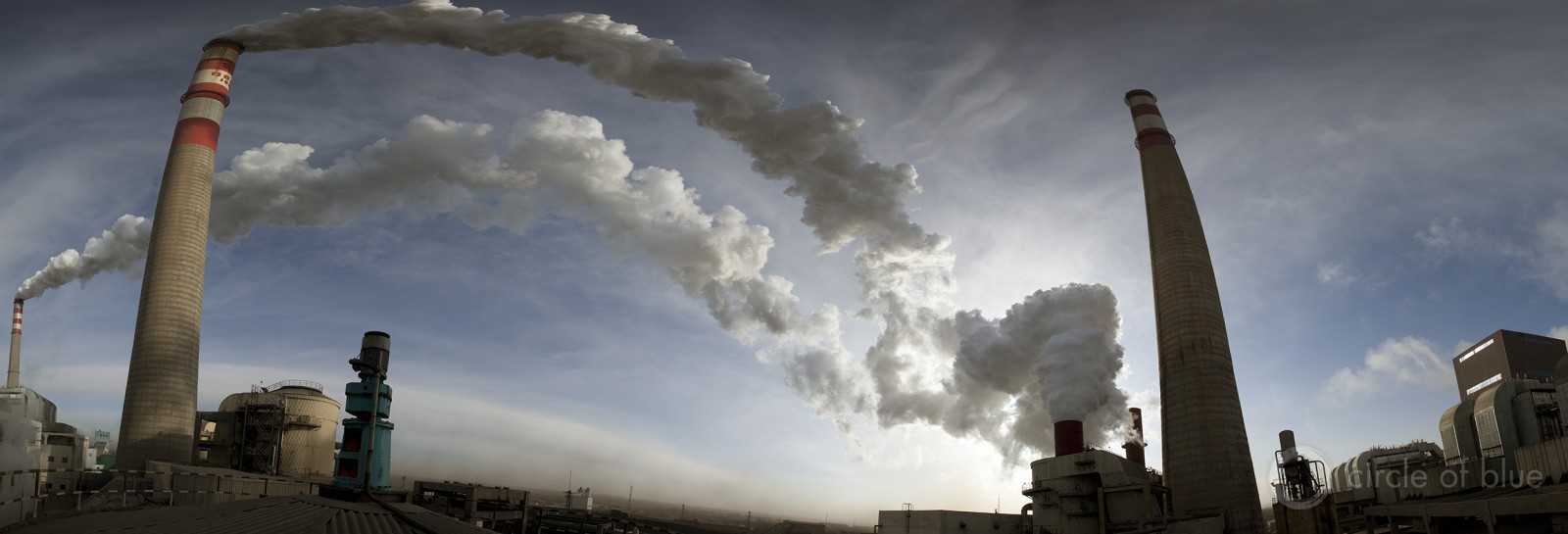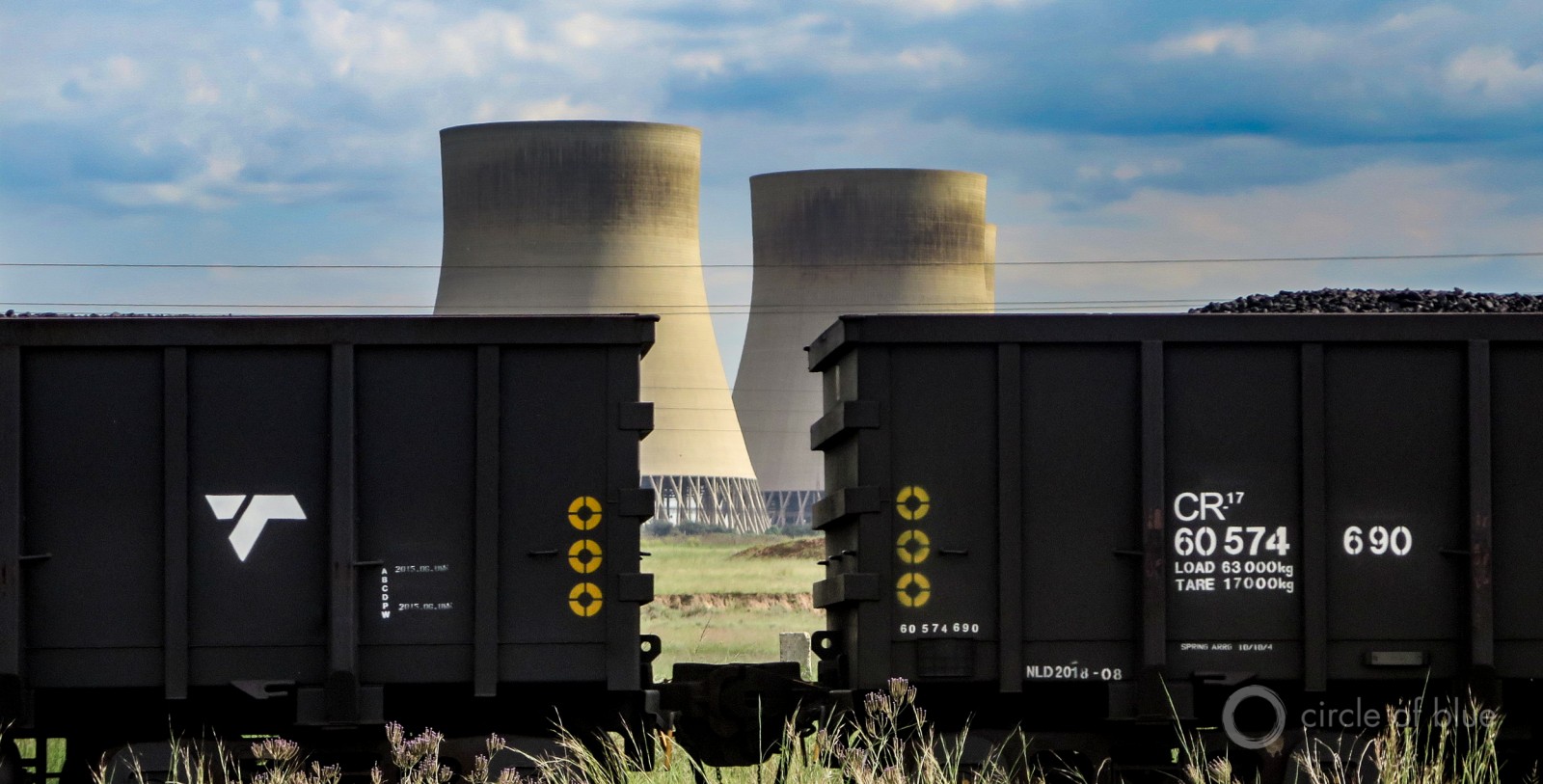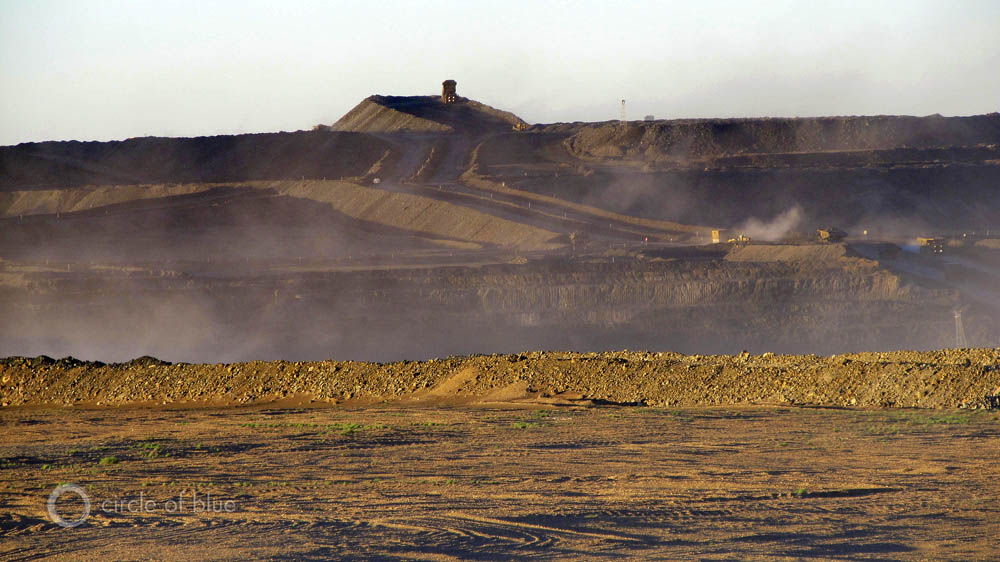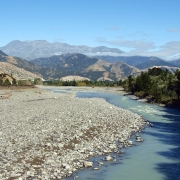Big Banks Finance Water-Damaging, Climate-Warming Energy Projects
Despite commitment to reduce national emissions, development banks spend $US billions on coal-fired power plants.

Coal combustion consumes immense amounts of water. In April, China issued a notice that it would not build 200 new coal-fired power plants capable of generating 105,000 megawatts of electrical capacity. That is equivalent to 10 percent of the generating capacity in the United States. Photo © Aaron Jaffe / Circle of Blue
By Keith Schneider
Circle of Blue
On April 4, just 18 days before 174 nations and the European Union ratified the Paris Climate Agreement meant to curb the use of coal as an energy source, police opened fire on 1,500 villagers protesting the damage to their water from two Chinese-financed coal-fired power plants in Chittagong, in southeastern Bangladesh. News organizations reported that four people were killed and 100 others were injured opposing the 1,224-megawatt, $US 2.4 billion plants’ construction.
In Turkey, national leaders propose to construct 70 new coal-fired power plants, a surge in fossil-fueled electrical generating capacity that also has generated fierce public protests in several communities. The China Development Bank is involved in building or planning 12 of those plants, according to the Climate Policy Initiative.
Both events illustrate a powerful economic and ecological disconnect between the diplomatic breakthrough in December in Paris to curb the use of carbon-based fuels, and limit climate-changing emissions to the atmosphere, and what is actually occurring at the global frontlines of energy production.
More Coal Plants, Not Less
Some 338 gigawatts of new coal-fired electrical generation are under construction around the world, principally in Asia, according to a March study by CoalSwarm, a global network of researchers. That is comparable to the generating capacity of all the coal-fired plants in the United States.
Nearly 1,100 gigawatts of coal-fueled generating capacity are in the planning stages. If even half of the plants planned and under construction operate as intended, that would pour upwards of 122 gigatons of carbon dioxide into the atmosphere over the next 40 years, said the researchers.
The consequences for the world’s ecosystems, and especially the planet’s freshwater reserves, are profound. Climate change already affects the stability of the world’s hydrological cycles, producing deeper droughts and more severe floods. Warming waters contaminated with nutrients have given rise to dangerous blooms of toxic algae. The 122 gigatons produced by half of the new and planned coal-fired power plants is a sizable share of the 141-gigaton to roughly 500-gigaton carbon dioxide budget that scientists say the world can produce in the next four decades and still keep the rise in global temperatures to under 2 degrees Celsius, the limit thought to secure human and ecological safety.

Australia, which suffered the severe consequences of a deep drought that ended in 2012, made big investments in coal production and export infrastructure. The question is, will that investment have substantial value over the 35-year design life of the facilities? Here, a coal loading terminal near Sydney. Photo © Aaron Jaffe / Circle of Blue
Heads of state recognize the peril. Last December, and again in April, the community of nations took a momentous step to address the hazard when they approved and then ratified the Paris Climate Agreement. The ecological torments that prompted nations to act were not just warming temperatures, choking pollution, and rising concentrations of carbon dioxide in the atmosphere. They also included the jagged pulses of seemingly random fury – the droughts and floods that leaders acknowledge have put freshwater reserves in danger, and imperiled a good deal of conventional energy production.
Financing Carbon Pollution, Water Insecurity
Yet even as heads of state formed the diplomatic consensus to make the world safer, major international finance institutions busily inked new agreements and prepared to dispense billions of dollars to build new coal-fired power plants. Bank investments, say activists, are foiling the goals of the Paris climate accord and are virtually certain to worsen the vortex of climate turbulence that grips the world.
“All of the models that forecast the negative effects of climate change say that to reach the goals of the Paris Agreement, construction of new coal-fired power plants needs to stop,” said Doug Norlen, director of the economic policy program at Friends of the Earth, and an expert in capital flows by multilateral investment banks. “Models show that to have half a chance of keeping warming under 2 degrees Celsius no new fossil fuel power plants of any type can be built after 2017. Between 2007 and 2014 Japan, China and Korea were the top government providers of public financing to coal plants, and all three continue to fund coal plants abroad.”
Though it took decades to form a global pact around limiting climate changing emissions, turning off 150 years of carbon-fueled industrial development amounts to one of the greatest challenges that humanity has ever faced.
Among the places to start, arguably the first place, is focusing on coal mines and coal-fired power plants, the source of 43 percent of climate change pollution and among the largest consumers and polluters of water on Earth. The second place is to understand what drives power plant development, especially access to the billions of dollars required to build and manage mines, and construct big new coal-fired plants.
The third step, say experts in global energy financing, is to convince the world’s biggest financial institutions to reconsider their responsibilities and lending practices devoted to producing electricity.
Agreement on Emissions, But Not On New Coal-Fired Plants
On that front, according to a community of public interest and academic research groups working on three continents, banks and nations are starting to move from financing high-carbon to investing in low-carbon fuel sources. For example, the World Bank, the second largest multilateral finance institution, says it no longer invests in most coal projects, including new power plants. A select number of governments have also indicated that they will no longer finance coal plants overseas, including the U.S., France, Scandinavian nations, and the Netherlands. Private banks and sovereign wealth funds also are starting to back away from financing coal projects. Last November, the Paris-based Organization for Economic Co-operation and Development (OECD), an alliance of 35 nations including China and the United States, reached agreement on “aligning export credit policies with climate change objectives to achieve lower emissions.” Support for the dirtiest coal-fired technologies would stop, said the organization, though critics asserted that the policy is not air-tight.
The evolution in financing comes during an era of severe disruption in the world’s coal markets. The number of coal-fired plants is declining in the U.S. as less expensive and cleaner alternative energy sources gain priority in electrical generation. China, the largest consumer of coal, earlier this year also cancelled over 200 new and proposed plants. International coal production has declined two straight years and prices have tumbled.
There is evidence, moreover, that the realignment in energy finance priorities, especially in the electrical generating sector, also is having some effect. The United Nations Environment Program found in its latest assessment of renewable energy financing that $US 265.8 billion was spent in 2015 on wind, solar, and small hydropower plants. The renewable energy sector added 118 gigawatts of new generating capacity last year, or nearly 54 percent of all new generating capacity around the world.
Trail of Big Money to Coal
It is not enough, say climate advocates. Trends in financing coal-fired electrical generation, and the damage to water resources that mining and burning coal causes, remain worrisome. The world’s big private, multilateral, and national development banks, led by the China Development Bank, continue to pour huge sums of capital into coal-fired power plants.

Coal trains form the backbone of South Africa’s coal transport system for power plants and for export. Photo © Keith Schneider / Circle of Blue.
A study in May by the Global Economic Governance Initiative, a research unit at Boston University, found that from 2007 to 2014 the China Development Bank spent an average of $US 16.8 billion annually on energy projects outside China, two-thirds on coal-fired power plants. Most of the financing was for power plants in Asia. China Development Bank officers did not respond to requests for an interview.
A separate study this year by the Rain Forest Action Network and several more environmental groups found that private banks, among them Bank of America, Citigroup, Barclays, Credit Agricole, Deutsche Bank and others, invested $US 42.39 billion in coal mining projects last year, and $US 134 billion in coal-fired power plants around the world.
A third study by Oil Change International, the Natural Resources Defense Council and four more environmental groups found in May that from 2007 to 2015 the G7 industrialized nations invested an average of $US 5 billion annually on coal mining and coal-fueled power projects around the world. Japan, which manufactures boilers and heavy equipment, was the top financier with $US 22 billion invested during those eight years in coal sector projects beyond its borders.
The torrent of credit, loans, and other financial instruments translates into a surprising number of new coal-fired plants proposed around the world. Oil and Gas 360, an industry news site, projects that 1,550 gigawatts of new coal-fired power generation is planned internationally, much of it in Asia. That is almost four times the coal-fired generating capacity that now exists in the United States, and more than new planned generating capacity for wind, solar, and natural gas fueled plants combined. “More than $US 1 trillion of power generation spending activity is planned for the next 24 months – mostly coal-fired,” said the news site.
Data compiled by Global Coal Plant Tracker, a database developed by CoalSwarm, reached consistent conclusions. It also found that nearly 1,100 gigawatts of coal-fired power is planned around the world. Construction expenses amounted to nearly $US 1 trillion.
Many Plants Will Not Be Built
How many plants will actually get built is anybody’s guess. CoalSwarm researchers calculated that half of the 1,700 gigawatts of coal-fired generating capacity proposed worldwide from 2010 to 2015 has been shelved.
“The hundreds of billions being thrown at coal could instead go toward the booming clean energy sector helping more than a billion people get access to the clean, reliable electricity that fossil fuels have failed to deliver,” said Nicole Ghio, senior campaigner for the Sierra Club’s International Climate and Energy program, and a coauthor of CoalSwarm’s “Boom and Bust 2016” report.
The damaging effects on water and land from mining and coal-fueled power plant construction are stirring a global rebellion. South African communities in KwaZulu-Natal and Limpopo provinces are battling to halt permits for proposed mines and three proposed coal-fired power plants.

For several years Mongolia’s economy has grown more than 15 percent annually, faster than all but a handful of countries, largely due to the mineral exploration and development in Omnogovi, the country’s largest province. Trucks loaded with coal make their way out of a mine in Tsogttsetsii. Photo © Keith Schneider / Circle of Blue
Turkey’s government insists the nation needs 70 new coal-fired power plants to serve its domestic electricity needs. Protests to protect rivers, lakes, and coastal estuaries from pollution from mines and power plants have erupted in many towns. According to the Climate Policy Initiative, the China Development Bank spent $US 2.7 billion to finance construction of three of Turkey’s newest coal-fired plants. The bank is prepared to finance nine more plants.
Bangladesh also has attracted China Development Bank financing for six new coal- fired power plants, according to Climate Policy Initiative. Reuters reported in April that “Dhaka plans to set up 25 coal-fired power plants by 2022, to generate 23,692 megawatts in order to meet rising electricity demand.” Several of the projects touched off protests over water safety that turned violent this year, said Rohini Kamal, a research fellow at the Global Economic Governance Initiative at Boston University.
“China speaks strongly about curbing climate change,” said Kamal in an interview from Dhaka, the Bangladesh capital. “Bangladesh does too. Their plans are good. The truth is, though, that they are bringing in workers to start building these plants. It doesn’t seem promising for meeting emissions commitments.”
Though geothermal and solar plants are part of the discussion for increasing Indonesia’s supply of electricity, coal continues to be a mainstay for the island nation. The hazards of Indonesia’s coal sector start with the country’s coal mines. In March, the bodies of two high school students were found drowned in an abandoned coal-mining pit in East Kalimantan, Indonesia’s principal coal production region. The teenagers’ deaths, according to Tessa Toumbourou, writing for Inside Indonesia.org, “bring to 22 the number of children that have drowned in unused, water-filled mining holes in East Kalimantan since 2011.”
Indonesia’s leaders have moved slowly to address the drownings and rehabilitate abandoned mines. A more urgent concern, they assert, is to bolster the country’s slumping domestic coal industry by promoting new power plants. In June, the government released the 10-year electricity supply plan that proposes 35,000 megawatts of new coal-fired power between now and 2025. According to the Climate Policy Initiative, the China Development Bank and other Chinese financial institutions helped to finance 30 existing and planned coal power plants in Indonesia.
Circle of Blue’s senior editor and chief correspondent based in Traverse City, Michigan. He has reported on the contest for energy, food, and water in the era of climate change from six continents. Contact
Keith Schneider









